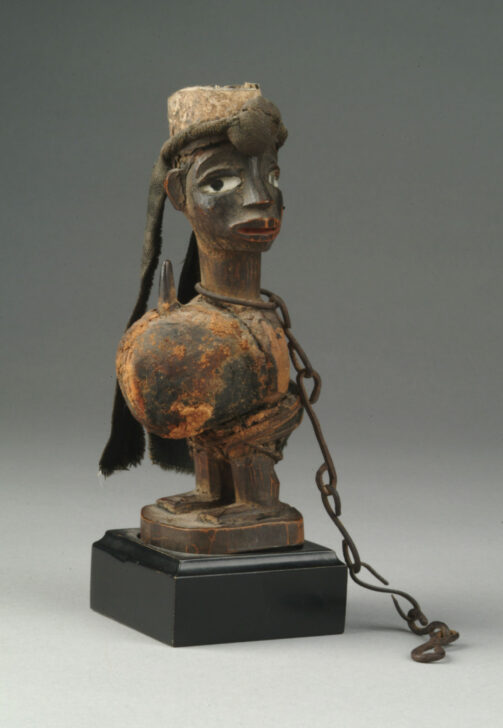Power Figure
Vili (Kongo)

Description
Subject Matter:
The term nkisi refers to both the spirit personality (pl. bakisi) controlling a particular activity or function as well as to the physical object (pl. minkisi) serving as an intermediary vehicle through which the spirit personality is accessed in order to fulfill a specific need for the living. Minkisi function either benevolently or malevolently to promote order and balance between individuals and within the community; thus, they possess the ability to heal, protect, promote success, and restore justice or to harm, inflict injury and illness, and exact revenge. Minkisi are designed, operated, and controlled by an nganga (pl. banganga), an expert healer and mediator of spirits and forces. What imbues the minkisi with power, however, is the collective, potent medicine they hold which the nganga meticulously prepares on behalf of clients. The medicinal substances, known as bilongo, include a myriad of vegetable, animal, and mineral ingredients such as seeds, leaves, shells, horns, feathers, claws, animal skins, and soil. Such ingredients were chosen for linguistic, metaphoric, and symbolic reasons rather than pharmacological ones; for example, the inclusion of a snake head would represent attacking power. These items are generally held in packets, bundles, and horns affixed to cavities or protrusions in the figure or tied around it; the absence of bilongo rendered an nkisi impotent and ineffectual. The nganga consecrates and activates minkisi in a context often involving prayers, songs, drums, and dance.
Here, the figure’s head is turned to its side which suggests both the ability to observe and discern as well as the quality of alertness. Its large eyes with dark pupils and the addition of mirror, the medium with which the nkisi sees, also reinforce the idea of vigilance since minkisi often function to protect individuals from potential harm. Its large eyes with dark pupils and the addition of mirror, the medium with which the nkisi sees, also reinforce the idea of vigilance since minkisi often function to protect individuals from potential harm. The long metal chain around its neck represents the nkisi’s ability to capture and restrain enemies. This figure bears a massive, protruding belly, upon which is affixed a small horn. The belly (mooyo) also means “life” or "soul" and is where bilongo was most commonly placed on minkisi. A bundle of bilongo is also found tied upon the figure’s forehead. The head is believed to be the site of communication with spirits, and therefore placing bilongo here maximized spirit interaction.
References:
African Form and Imagery: Detroit Collects. Ed. Judith A. Ruskin. Detroit: Detroit Institute of Arts Founders Society, 1996.
Felix, Marc Leo. 100 Peoples of Zaire and Their Sculpture: A Handbook. Brussels: Zaire Basin Art History Research Foundation, 1987.
_____. Art et Kongos. Brussels: Zaire Basin Art History Research Center, 1995.
A History of Art in Africa. 2nd Edition. Eds. Monica Visona, Robin Poynor, and Herbert Cole. Upper Saddle River, NJ: Pearson Education, Inc., 2008.
LaGamma, Alisa. Art and Oracle: African Art and Rituals of Divination. New York: The Metropolitan Museum of Art, 2000.
MacGaffey, Wyatt. Excerpt from an Unknown Publication in Object Folder for 2005/1.191.
MacGaffey, Wyatt and Michael Harris. Astonishment and Power: Kongo Minkisi & The Art of Renee Stout. Washington, DC: Smithsonian Institution Press, 1993.
Maurer, Evan M. and Niangi Batulukisi. Spirits Embodied: Art of the Congo, Selections from the Helmut F. Stern Collection. Minneapolis: The Minneapolis Institute of Arts, 1999.
McClusky Pamela. Art from Africa: Long Steps Never Broke a Back. Seattle and Princeton: Seattle Art Museum in association with Princeton University Press, 2002.
Simon, Kavuna and Wyatt MacGaffey. “Northern Kongo Ancestor Figures.” African Arts. 28:2 (Spring 1995): pp. 48-53+91,
Physical Description:
This anthropomorphic nkisi, or power figure, stands upright with its head turned 90 degrees to the side. Like many minkisi, this one features a wide range of materials. A long metal chain hangs around its neck and a fiber packet containing medicinal substances is tied across its forehead with its loose ends dangling far below. More fiber is wrapped around its lower torso. The face features a slightly parted mouth and large eyes with attentive, black pupils. Protruding from the figure is a large, prominent belly, upon which is affixed a small horn.
Usage Rights:
If you are interested in using an image for a publication, please visit https://umma.umich.edu/request-image/ for more information and to fill out the online Image Rights and Reproductions Request Form.